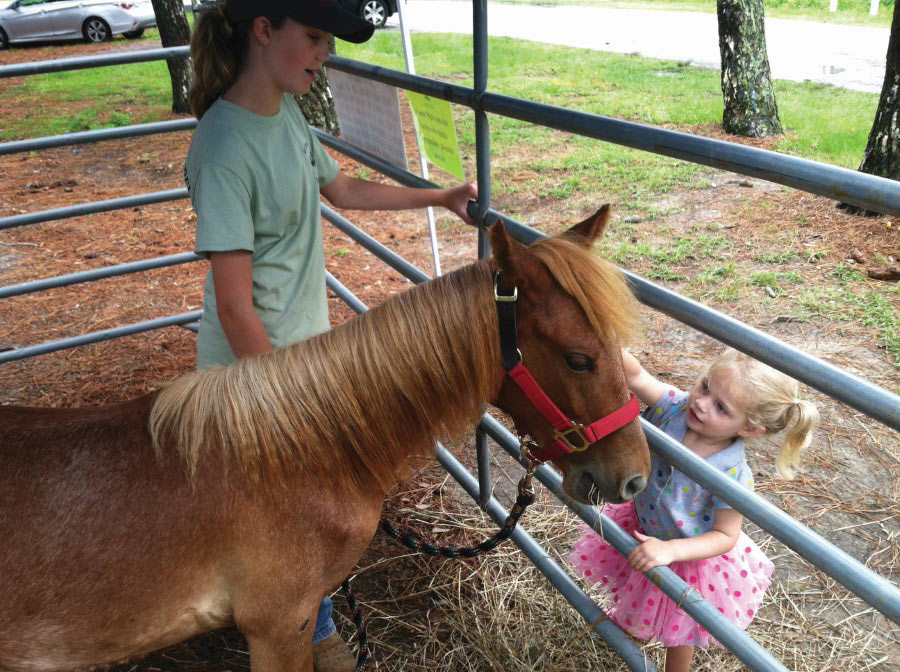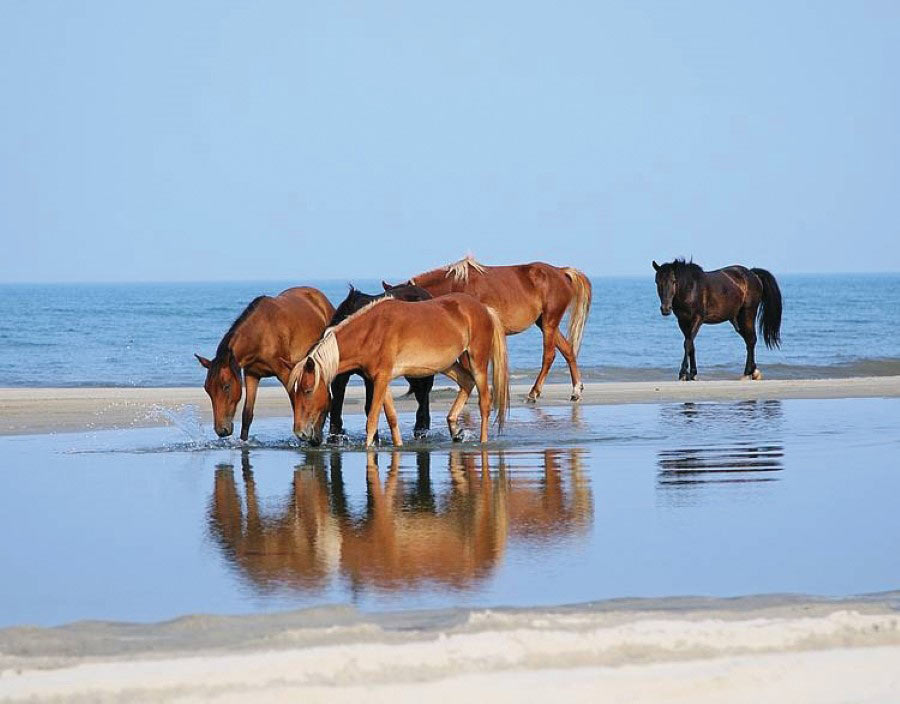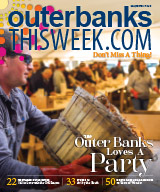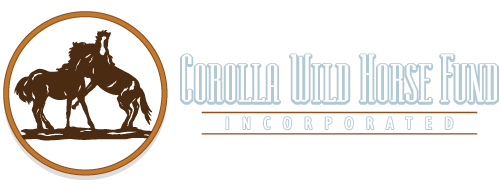
His fiery personality, protective nature and good looks make him a popular one with the ladies – and his recognizable offspring prove he gets around! But don’t go calling Topnotch a scoundrel – among the Corolla wild horses, he sets himself apart as a model stallion.
Topnotch has long been a favorite of the Corolla Wild Horse Fund. His chestnut-colored coat distinguishes him from the majority of the herd’s darker members, and he sports white socks on each leg – the only member with a full set of four. When it comes to stirring up mischief, he lies low compared to the other members of the herd, preferring to stay with his mares near the Carova Fire Station.
“He takes good care of his mares,” Herd Manager Meg Puckett says. He tends to keep his harem close to him, protecting them from other horses and preferring to stay in the safer environment in Carova (unlike some stallions who lead their mares and foals past the north gate or on to busy roads). It’s easy to see his appeal.
His companionship with his mares makes identifying his foals easy. As time passes, their resemblance to Topnotch (whether from their shared chestnut coat or similar white socks) helps the Fund recognize them and track their movements.
Take Bonita, for example. This rescued member of the herd now lives at the Fund’s farm and rehabilitation center in Grandy, but the Fund knows all about her past life in the wild. They snapped a picture of her the day she was born, while Topnotch hovered in the background, keeping watch over the mare and foal. Over the years, Bonita grew and found her own harem to join. However, she remained easy to track, thanks to her light coloring and set of three white socks. And she shares such characteristics with many of Topnotch’s offspring.

The stallion’s qualities make him a keystone for the Fund’s latest research: establishing a breed registry that documents the horses’ genealogy and history.
Across the country, other herd management entities maintain similar breed registries. It helps them track the horses’ lineages and individual lives and also preserve their stories. By following Topnotch’s offspring and those of other horses through this registry, the Fund can record and observe how the horses’ lineages play out across the decades and document their stories. In the future, they’ll have the capacity to point out more horses and connect them to a foundational generation, such as Amadeo (the herd’s oldest known member until his passing in March 2020) and Amadeo Jr. (who still thrives in the wild). And, alternatively, any grandchild offspring of Topnotch, should the Fund choose to breed Bonita.
“It’s kind of like putting a puzzle together and fantastic to build that history,” Meg says. She even mentions using the possibility of developing the registry through DNA testing.
This and other areas of the Fund’s research can be explored at the Corolla Wild Horse Museum and gift shop in Corolla. April 2020 marks the Fund’s and museum’s return to Historic Corolla Village! In anticipation of the new space, they are redesigning the museum’s layout with panels on the walls and informational displays flowing through multiple rooms. Now visitors are treated to a self-guided exhibit upon entering the museum. Their expanded literature and informational material have revolutionized the way the public learns about the herd’s history, “celebrity” horses and the Fund’s work.
Perhaps more exciting, people’s ability to see the horses in action hit a new potential in the past year: The Fund unexpectedly created a new site for their outreach work and programs when they added their rehabilitation facility and farm in 2018. With more than a dozen rescued members of the herd – including Bonita and even Raymond the mule – onsite, these horses serve as ambassadors for the Corolla wild horses and the Fund.
“There’s an active role for them here,” Fund Chief Operating Officer Jo Langone says. Those that have been gentled assist in the Fund’s programs and activities. The best part? The farm’s accessible location just off U.S. Highway 158 in Grandy makes it easy to visit and doesn’t require the horses to be transported to an offsite location.
In previous years, the Fund took the horses by trailer to programs on the beach. However, a lot can go wrong when moving a horse, especially over the bridge: It may be too hot. No one wants to get caught in traffic while towing a horse trailer. And if it storms? Jo shudders. “I don’t want to even think about that.”

Transporting a horse poses a challenge to scheduling events on the beach. For example, of the six Meet a Mustang events the Fund planned to hold in Nags Head, Duck, and Corolla during the 2019 summer season, only two actually happened.
“It’s good to have the rehabilitation center as a constant,” Jo says. They started hosting weekly open houses, Mustang Mornings, at the farm during the summer of 2019. Visitors could come and see the horses, meet the herd manager and trainer and observe how they interact with the rescues. Event turnout evidenced people’s eagerness to see the horses and the Fund’s work in action.
The regular and safe environment for the rescued horses enables events to arise spontaneously – a concept out of the question for events on the other side of the bridge. In 2019, their Fall Festival and Christmas with the Corollas came together seamlessly and with much less advance preparation. The festivals drew out more Outer Banks locals than the summer’s programs.
In its 2020 season, the farm looks forward to continuing its popular programs, including Mustang Mornings and Meet a Mustang. Check out the Fund’s Facebook page and website to stay up-to-date on the schedule for these programs and learn about special events, such as concerts and festivals at the farm or other locations.
Another exciting development for the Fund is their new office and museum location in the heart of Corolla Village. The museum and gift shop give people the chance to deepen their knowledge for these banker ponies and celebrate their love for all things horse. New in 2020, the museum debuts a detailed exhibit of panels that illustrates the complete history of the wild horses. Jo talks excitedly about this opportunity to expose more audiences to the herd’s story and significance: The story of the horses begins at the museum’s entrance, and as observers read along, they work their way through the museum and the herd’s history up to today.
And while we know better than to judge a museum on its gift shop, the Fund’s definitely challenges this practice. The emporium of horse-themed goodies offer a treasure trove to make any horse enthusiast swoon. Browse the Fund’s t-shirts and sweatshirts, horsehair bracelets, horse-inspired pottery and photos of the wild horses by local artists, horse wine (trust me) and postcards. If you run short on time or prefer the comfort of shopping from your own home, you can order these products through the Fund’s website.
The future looks good for the Fund. Through their expanded facilities, new locations and cutting-edge research, we’re protecting the horses, understanding their stories and interacting with them better than ever before.
If You See the Wild Horses, Remember:
Don’t approach the horses. If they come to you, it’s your responsibility to move. County ordinance states you must keep 50-feet away from the horses at all times.
Don’t feed the horses. Their highly specialized diet makes foods that humans and even domesticated horses eat dangerous – even deadly – to their health.
If you see a horse that looks injured or sick, contact the Fund at (252) 453-8002.
(252) 453-8002
corollawildhorses.org



 Hannah Lee is a fiction and creative nonfiction writer living on the Outer Banks. She graduated from Kenyon College in Ohio with a degree in English Literature and Creative Writing. Traveling is her passion, but nowhere ever feels as much like home as the Outer Banks. When not planning her next trip or adventure, Hannah Lee loves aimless drives down the Beach Road, spending copious amounts of time in coffee shops and reading every short story collection she gets her hands on.
Hannah Lee is a fiction and creative nonfiction writer living on the Outer Banks. She graduated from Kenyon College in Ohio with a degree in English Literature and Creative Writing. Traveling is her passion, but nowhere ever feels as much like home as the Outer Banks. When not planning her next trip or adventure, Hannah Lee loves aimless drives down the Beach Road, spending copious amounts of time in coffee shops and reading every short story collection she gets her hands on. 




